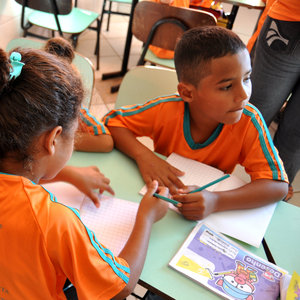Igarapé Institute develops new technologies to assess how children experience insecurity in Brazil
[Press Release] August, 2016
Campaign #MakingChildrenSafer is being launched this week
The way people perceive personal security seldom corresponds with objective levels of security. In Rio de Janeiro, for example, despite rising concern with homicidal violence and crime, the murder rate is well below the national average (21.1 as compared to 29.1 homicides for every 100,000 inhabitants[1]) and at one of the lowest recorded levels since records started being collected. Even so, how people interpret security inevitably affects their behavior and decisions.
There is comparatively limited reliable data about how young Brazilians perceive their security environment. National censuses and crime surveys very rarely generated information on the subject. In order to fill this knowledge gap, the Igarapé Institute and its partners developed the Child Security Index (CSI), a mobile-based app that records the experience of adolescents and children in low-income settings. The CSI has been tested in 14 cities in Brazil, including Rio de Janeiro.
New report
The Igarapé Institute is launching a new report summarizing results from the CSI in Rio de Janeiro. The report Infância e Segurança (Childhood and Security) draws attention to the ways kids are exposed to violence and solutions to improve their safety. The report included interviews with 326 children between 8 and 17 years old. The focus was on residents in selected neighborhoods of the North Zone of the city. In Rio de Janeiro, the Igarapé Institute worked with Bola Pra Frente, an NGO working on improving life opportunities for young people.
The new report finds that children tend to feel more secure at home, in school, and in their neighborhood than teens. Only 30% of adolescents responding said they feel safe on the street. Approximately 17% of children and 26% of adolescents don´t feel protected by the police. And while 55% of respondents report claim to have experienced some form of physical punishment, they still register relatively low levels of fear than might be expected.
“Our objective is to give voice to children from insecure and low-income environments. We aim to map – across time and space – their perceptions of safety. By giving them voice, we want to help them become active agents of public policy formation, and not just passive subjects,” says Robert Muggah, the research director of the Igarapé Institute.
According to Renata Giannini, the author of the latest CSI study on Rio de Janeiro, “children’s and adolescents’ rights and guarantees are not being respected. Mega-events like the Olympics can give rise to new risks for children, especially girls. This study shines a light on the scale of the problem”.
A new campaign
The Igarapé Institute is launching a new campaign starting on 7 August to shine a light on the scale and magnitude of violence against children. Before, during and after the Olympics, the Institute will launch the latest report on Rio de Janeiro, together with infographics, new reports on 12 other cities across Brazil and a video. The Institute is working with partners such as World Vision International to get the message out in Brazil, but also around the world.
A key objective of the campaign is also to identify tech-enabled solutions to improve the safety of children. The campaign will show how technology can be used to quickly evaluate child and adolescent security in Brazil and beyond. The Igarapé Institute is working with a range of partners such as Bernard van Lear Foundation, Google Brasil, Oi Futuro and World Vision International to highlight experiences in homes, at schools, and in neighborhoods.
Read the publication (in Portuguese)
Other publications about the CSI:
More Information about the project
Campaign
On social networks use #MakingChildrenSafer
[1] Source: Homicide Monitor 2015, Igarapé Institute. (homicide.igarape.org.br)



